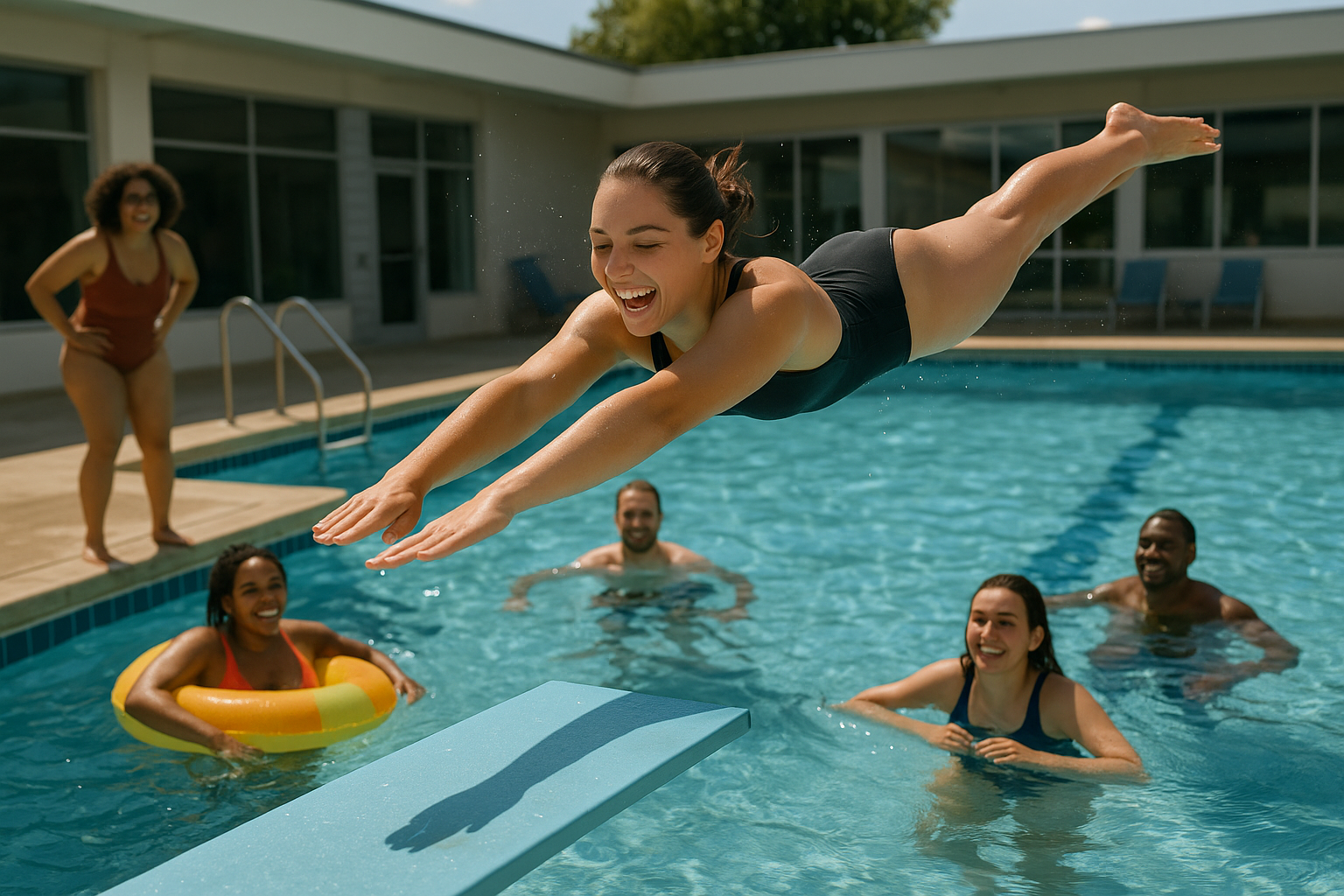💧 Whether you were at the pool, the lake, or the ocean, chances are, you needed a little boost of confidence to take that full plunge. If you are here, it means that you’re ready to dive back into that memory, strengthen your water confidence and make a splash.
Regardless of your age or swimming abilities, there’s always room for improvement when it comes to water confidence. It’s a continuous journey of self-improvement and exploration, just like any other skill. A bit of practice, the right guidance, and some effective tips can help you boost your confidence and make swimming an even more enjoyable experience. 🏊♀️
What to Expect
This article is your comprehensive guide, packed with expert tips and advice, to help you gain confidence in the water and take your swimming skills to new depths. We will tackle everything from fundamental swimming techniques, overcoming water-related fears, and even progressing to advanced swimming styles. Each section is designed to provide you with valuable insights, practical tips, and action points to improve your water confidence step-by-step.
Why Water Confidence Matters
Whether you are a seasoned swimmer looking to refine your stroke or a beginner who wants to learn the basics, water confidence is crucial. It’s not just about being able to swim – it’s about being comfortable, safe, and secure in the water. And that confidence doesn’t just benefit you in the pool, but extends to various aspects of your life, including physical health, mental well-being, and even social skills. 🏊♂️
Building Blocks for Water Confidence
We’ll start by laying down the building blocks for water confidence. This includes understanding the principles of buoyancy, breath control, and body movement in the water. It may seem a bit technical, but don’t worry, we’ll break it down into easily digestible tips and practical exercises that you can incorporate into your swimming routine.
Overcoming Water-Related Fears
Water-related fears are common and can be a significant barrier to building water confidence. If you’re grappling with such fears, we’ll share some strategies and techniques to help you overcome them and feel more at ease in the water. After all, the more comfortable you feel, the more you’ll be able to enjoy the water, and the faster your confidence will grow. 🌊
Advanced Swimming Techniques
Once you’ve nailed the basics and conquered your fears, we’ll dive into more advanced swimming techniques. From perfecting your breaststroke to mastering the butterfly, these techniques will help you become a more proficient and confident swimmer. We’ll also share some drills and exercises to help you practice and improve your skills.
In a nutshell, this article is your all-in-one resource to boost your water confidence. Whether you’re looking to enhance your swimming skills, overcome water-related fears, or simply want to feel more comfortable in the water, you’ll find valuable tips and advice here. So, get ready to dive in and make a splash! 🌊💦
Understanding Your Relationship with Water: Setting the Foundation
Before diving into the deep end, it’s essential to understand your relationship with water. Many people experience trepidation when it comes to water activities, often due to past traumatic experiences, fear of the unknown, or simply a lack of familiarity. In fact, according to a study conducted by the American Red Cross, over half of all Americans either can’t swim or don’t have all of the basic swimming skills. If you find yourself in this demographic, don’t fret. With the right approach, you can transform your relationship with water from one of fear to one of confidence and enjoyment.
Start by identifying what scares you about water. Is it the depth? The feeling of being out of control? Not knowing what’s beneath you? Once you’ve pinpointed the root of your fear, you can begin to tackle it head-on. Consider seeking professional help if you’re having trouble overcoming your fear. Therapists can provide you with coping strategies such as cognitive behavioral therapy, which can be extremely effective in managing phobias.
For a detailed explanation of how to overcome aquaphobia, check out this insightful YouTube video titled “Overcoming Fear of Water and Swimming” by expert swim instructor Tripp Holland. In this video, Holland provides a step-by-step guide on how to become comfortable in the water, starting from the basics.
Building Confidence in the Water: Steps to Take
Building confidence in the water is a gradual process, and it’s crucial to take it step by step. Here are some strategies that can help:
- Start Small: Begin in shallow water where you can easily touch the bottom. Practice getting your face wet, holding your breath underwater, and floating. Gradually move to deeper water as you become more comfortable.
- Learn to Float: Mastering the skill of floating can dramatically increase your confidence in the water. Practice in a safe and calm environment, and take your time. Remember, everyone learns at their own pace.
- Take Lessons: Consider enrolling in swimming lessons. A qualified instructor can provide you with the skills and techniques needed to feel secure in the water.
For a comprehensive guide on building confidence in the water, check out this informative YouTube video, “7 Tips to Get Over Fear of Water | Swimming Lessons,” by the swim instruction channel, Simply Swim.
Comparison of Different Swimming Styles: What Works Best for You?
Swimming styles, also known as strokes, can significantly impact your comfort and efficiency in the water. There are four main types of strokes: freestyle, breaststroke, backstroke, and butterfly. Each stroke has its own unique set of characteristics, advantages, and challenges. Understanding these differences can help you determine which style suits you best.
| Stroke | Characteristics | Advantages | Challenges |
|---|---|---|---|
| Freestyle | Most common stroke, involves alternating arm movements with a flutter kick. | Fast and efficient, great for long distances. | Requires good coordination and breathing technique. |
| Breaststroke | Involves simultaneous movements of the arms on the same horizontal plane. The legs perform a frog kick. | Can be done slowly and comfortably, head stays above water. | Not as efficient or fast as other strokes. |
| Backstroke | Performed on the back with alternating arm strokes and a flutter kick. | Face stays out of water, making it easy to breathe. | Lack of visibility can lead to collisions and difficulty staying in a straight line. |
| Butterfly | Most physically demanding stroke. Involves a dolphin kick and windmill arm motion. | Fastest stroke when performed correctly. | Requires significant strength and stamina, difficult to master. |
For a visual guide on how to perform these strokes, watch the YouTube video “Learn to Swim: The 4 Swim Strokes Explained” by the channel Skills NT Swimming.
Water Safety: Prevention is Better than Cure
Water safety is a critical aspect of being confident and comfortable in the water. Always ensure that you’re swimming in a designated area, supervised by a lifeguard if possible. It’s also important to understand your limits and not push yourself too hard, especially when starting out. Always have a swimming buddy, and avoid swimming in hazardous conditions.
For more detailed water safety tips, watch the YouTube video “Top 10 Water Safety Tips” by the American Red Cross.
Boosting your water confidence isn’t just about becoming a skilled swimmer. It’s about fostering a positive relationship with water and understanding how to stay safe while enjoying all the benefits swimming has to offer. So take your time, be patient with yourself, and most importantly, don’t forget to have fun. Remember, every master was once a beginner.

Conclusion
In conclusion, after a detailed exploration of the various aspects and applications of Software Engineering, it becomes evident that this field holds a significant place in our current digital era. 🌐💻
We have traversed through the definition of Software Engineering, discussing its importance and the benefits it brings to businesses worldwide. We’ve also delved into the key principles and methodologies, such as Agile and DevOps, which play an integral role in the successful implementation of software projects.
Software engineering, with its unique blend of technical knowledge and creative problem-solving, contributes towards providing efficient solutions to complex business problems. As we discussed earlier, it’s not just about writing code but also involves stages like requirement gathering, design, coding, testing, and maintenance.
This article also highlighted the crucial role of software engineers in the digital transformation of businesses. Their expertise is vital in creating innovative software products and services, thereby enhancing the business value and customer experience. 🚀👨💻
Moreover, we’ve looked at the evolving trends in software engineering, such as AI and Machine Learning, Cloud Computing, and Cybersecurity, which have reshaped the technology landscape and will continue to do so in the future.
The importance of continuous learning and upgrading skills in this ever-changing field was also stressed upon. In the rapidly evolving tech world, staying current with the latest trends and technologies is not an option but a necessity. 📚💡
In closing, I hope this comprehensive guide has provided you with valuable insights into the world of software engineering and has ignited a spark to delve deeper into this fascinating field. Your engagement and feedback are highly appreciated, so feel free to comment, share, or apply what you have learned. Remember, every step you take in learning and applying your knowledge is a stepping stone towards your success. 💪🏼🎯
For further reading and research, you might find these resources helpful:
– [Software Engineering Institute (Carnegie Mellon University)](https://www.sei.cmu.edu/)
– [IEEE Software Engineering](https://www.computer.org/technical-committees/software-engineering/)
– [Google Scholar](https://scholar.google.com/)
Please note that these links were active at the time of publishing.
Until next time, keep exploring, keep learning! 🚀🎓
Tags: #SoftwareEngineering #Technology #DigitalTransformation #Agile #DevOps #AI #MachineLearning #CloudComputing #Cybersecurity #ContinuousLearning



